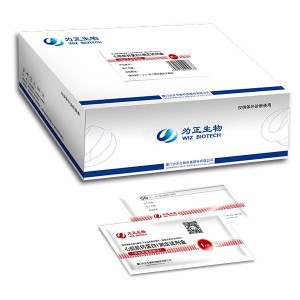Khan, G. et al. Cardioprotective effect of green tea extract on doxorubicin-induced cardiotoxicity in rats. Acta Pol Pharm. 71, 861–868 (2014).
Rubella-lgM nồng độ vi hạt (9,2336%), Kháng thể IgM (kháng thể đơn dòng chuột, IgG) (2,4414%),
Traditionally, hemagglutination inhibition (HAI) assays and neutralization tests (NTs) have been used for dengue diagnosis down to the serotype level. However, these methods are time consuming, labor intensive with low throughput, and are not cost-effective. Several commercially available laboratory-based IgM and IgG ELISA kits are also available and have sensitivities ranging from 21% to 99% and from 8% to 89%, respectively, and specificities ranging from 52% to 100% for IgM and 63.5% to 100% for IgG, compared with gold standard laboratory-based ELISAs (18). With advances in technology development, the ELISA, especially M antibody capture (MAC)-ELISA, signifies the most important advance for IgM detection for routine dengue diagnosis. The MAC-ELISA is based on detecting IgM in serum using human-specific IgM that is bound to the solid phase. MAC-ELISAs are frequently run as a nonquantitative single dilution test, and positive results are commonly reported as a ârecent flavivirus infection.â However, because IgM circulates for up to 3 months or longer, its presence might not be diagnostic of a current illness. To diagnose a current dengue virus infection, the demonstration of a seroconversion or at least 4-fold changes in antibody titers in paired sera is required. In areas where dengue is not endemic, IgM-based assays can be used in clinical surveillance for viral illness or for random population-based serological surveys, with the likelihood that any positive results detected indicate recent infections (within the past 2 to 3 months).
Another recent study has evaluated this new technique (9). The methodological approach is different and complementary (in relation to our work). This study uses 180 sera: 115 chronically infected persons with known serotype (48 serotype II, 14 serotype I-III, serotype I-IIIa, and 28 serotype atypical, haplogroup 12), 51 seronegative samples, and 13 samples from recently infected persons. In this study, the ICT test had 100% sensitivity and specificity. The authors also developed the theme of economic considerations, and we agree that the ICT test offers new options for improved prenatal care in low- and middle-income countries; it facilitates early identification and diagnosis, with similar or better sensitivity and specificity than automated techniques.

WHAT WE NEED TO KNOW: What are the essential differences in the inflammatory process that lead to different pathological outcomes in asthma and chronic obstructive pulmonary disease (COPD)? What factors cause some patients with asthma to have clinical features indistinguishable from COPD, and should these patients be treated differently from those with early-onset, atopic asthma? What should be added to FEV(1) improvement after bronchodilator to enhance the ability of spirometry to distinguish between asthma and COPD? Why is disturbed gas exchange characteristic of stable COPD but rare in asthma? Why and when does COPD become a systemic disease with multiorgan dysfunction, while asthma generally does not? Does the response to bronchodilators in asthma and COPD predict prognosis and response to other interventions? Do people with asthma (airway obstruction, hyper-responsiveness and atopy) and COPD (fixed airflow limitation) have different natural histories, responses to treatment and prognoses? WHAT WE NEED TO DO: Evaluate new diagnostic tools (eg, indirect markers of inflammation) for asthma and COPD. Target older people in epidemiological studies to identify and describe the extent of asthma. Initiate community awareness programs to help older people with dyspnoea recognise they may have symptoms of asthma or COPD that should be assessed by a doctor. Define the clinical and physiological features of asthma and COPD in older people that indicate when and which treatments will achieve maximum benefit with least harm. Develop strategies for better, patient-focused care of people with severe airway disease, concentrating on device use, action plans, side effects, end-of-life decisions, exercise and independence in activities of daily living. Maintain research into new drugs and targets for preventing progressive loss of lung function in asthma and COPD.
Medical diagnostic tools (e.g., biosensors) respond to biochemical and physiological signals of interest and relay this information in the form of electrical or optical output, thereby reliably diagnose diseases and illnesses1. These devices, however, while readily accessible in developed countries, are often costly and complex to the average untrained person, and not easily accessible in all regions of the world2. To aid in reducing global health care costs, point-of-care (POC) diagnostics aims to provide patients with rapid real-time clinical testing and treatment, primarily in developing countries which are lack of medical facilities. Diagnosis systems of this caliber must be inexpensive, easy to use and disposable due to limitations in trained personnel, infrastructure, medical instruments, and operational funds3,4. Recent diagnostics research is showing a trend toward not only the design of low-cost instruments that are easy to use5,6,7,8,9,10,11,12,13, but also the integration of testing applications into mobile devices. Smartphones, which have millions of users worldwide including third-world regions, can be adapted for diseases detection2,3,4, and the wireless system can relay patient information and test results to health professionals for further analysis if necessary. To date, POC devices already in use include glucose meters, pregnancy tests, and infectious disease tests which commonly employ strip testing using colorimetric, fluorescence, or electrochemical detection methods5,14. Detection methods employing mobile devices have predominately adapted to the traditional approaches; colorimetric detection has been studied most thoroughly3,4,15,16,17,18,19,20, though researchers have demonstrated that electrochemical8,21 and luminescence-based methods22 are also feasible options.
One of the most common bits of feedback I receive about my writing in any context is that it is extremely clear. I believe I say exactly what I feel and think. I don’t think anything I say is veiled or obscure in any way. I just don’t do that. So there is nothing more for Zionists to say to me. What can they say? I just want them to be as straight as I am, and tell the truth. But the truth doesn’t look good and they will hold on to their deceit all the way to the end, although it screams clearly from all of Israel’s actions. They just won’t name it and engage in pseudo intellectual debates about something that is not up for debate. A crime is not something you debate. I don’t see Jewish people or Israel giving Nazi war criminals an opportunity to argue their case for why ‘race science’ is reasonable and genocide is a perfectly OK thing to commit. I don’t see us debating with pedophiles the merits of abusing children. We should not debate with Zionists the merits of settler-colonialism. there is nothing to debate. There are no two sides to a story of abuse and a crime committed in the context of a gross imbalance of power.
The European Randomised Study of Screening for Prostate Cancer (ERSPC) was conducted in eight European countries.5 There was possibly inadequate allocation concealment, and there are concerns that groups may have received different quality of treatment for prostate cancer (performance bias). Nevertheless, the systematic review authors judged the ERSPC trial to be the one that was probably least affected by bias. Based on a predefined sensitivity analysis,1 the BMJ Rapid Recommendations panel decided to appraise both the summary of the whole body of evidence as well as selected data at lower risk of bias from the ERSPC study (see main infographic).

While a state cannot claim illegally annexed territory as its capita, the whole case becomes different if one just claims that it is the “capital of the Jewish people”.
© 2015 Elsevier Ltd. Background An overlap between obesity and asthma exists, and inflammatory cells in adipose tissue could drive the development of asthma. Comparison of adipose… [more]
Several rapid IgM-based dengue diagnostic tests have also been developed as a quick and easy method for use at the point of care and exist in different formats, including particle agglutination and lateral-flow immunochromatographic strips, with or without plastic cassettes. Most of these tests use recombinant antigens from all four dengue virus serotypes, and the results are available within 15 to 90 min. Several studies have evaluated these commercially available rapid IgM- and IgG-based kits and have been reviewed recently (18). The IgM- and IgG-based kits have sensitivities ranging from 53% to 82% and from 62% to 89%, respectively, and specificities ranging from 75% to 100% and 67% to 95%, respectively, compared with gold standard laboratory-based ELISAs. Even though the rapid tests’ performances are not as sensitive and specific as those of ELISAs, the performance is still acceptable, with results available in a short time frame without laboratory requirement. Recently, a novel lateral-flow assay scheme that uses two-color latex labels for rapid multiplex detection of IgG/IgM antibodies to DENV and chikungunya virus in 10 min was reported by Lee et al. (48) (Table 3). With further clinical validation performed, this assay has significant potential as a POCT for the differential diagnosis of numerous pathogens of interest analyzed quantitatively in an automated point-of-care setting. Another novel integrated device was reported to detect and interpret the ELISA results on a portable lab-on-compact-disc (LOCD) platform by Thiha et al. (49) (Table 3). The system applies absorption spectrophotometry to measure the absorbance (optical density) of the sample using a monochromatic light source and an optical sensor. The device allows automated analysis of the results in a quantitative manner, with 95% sensitivity and 100% specificity (Table 3) in dengue virus detection compared with gold standard commercial ELISA microplate readers.
Prostate cancer is one of the most common cancers in men and is the leading cause of cancer death in 24 countries, ranking eighth globally, sixth in high income countries, and 12th in low income countries.3 Prostate cancer screening is with a PSA blood test. A raised PSA level can be a sign of prostate cancer but can also occur due to a non-cancerous enlargement or inflammation of the prostate.4 Many men have a raised PSA level without having cancer (that is, false positive results). Conversely, a substantial number of men with a low PSA level will subsequently be diagnosed with prostate cancer (false negative results).
Older Men Gain Little From PSA Test: Study â WebMD | Cpn-Igm Related Video:
We always get the job done to be a tangible staff to ensure that we can easily offer you the best high-quality and the greatest value for Pct Rapid Test Kit , Dengue Rapid Test , Pgi Diagnostic Kit For Pepsinogen I/Ii , We taking advantage of experience workmanship, scientific administration and advanced equipment, ensure the product quality of production, we not only win the customers' faith, but also build up our brand. Today, our team is committed to innovation, and enlightenment and fusion with constant practice and outstanding wisdom and philosophy, we cater to the market demand for high-end products, to do professional products.






